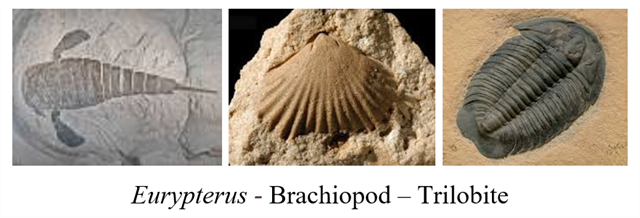
EARTHCACHE REQUIREMENTS
Each cacher must send his/her own answers BEFORE logging a find. Enjoy the journey (learning adventure) as well as the destination (smiley earned). Remember to take only pictures and leave only footprints. To get credit for this Earthcache, complete the following tasks:
Answers via message -and- log signature picture are required to post a find for this cache.
1. MESSAGE …. What is the amount of falling water you see at the time of your visit? Use the magnitude of flow chart to answer this question.
2. MESSAGE …. Describe how this falling water is eroding the cliff. Give a specific example either in words or with a pic.
3. MESSAGE …. a. Describe the matrix (rock). b. What tools (if any) did you use?
4. MESSAGE …. ... Find four fossils. Either identify or describe them.
LOG ... Post a picture of you or your signature item and the fossils you found. This picture is your log signature.
OPTIONAL - Please respect the time and effort involved in creating this earthcache by adding A and B to your log.
A. JOURNEY OF THE MIND ... Science explains what we observe. Relate (in your own words) something you found interesting in the reading. This adds to your learning adventure and your log.
B. JOURNEY OF THE HEART ... Art shares our personal experience of what we see. Share something special you found on site, and why it is special to you. This is a memorable addition to your log and will make other hearts smile.
Journeys of Heart and Mind ...
Stories to Touch the Heart and Puzzles to Challenge the Mind / Rainbow Tree Story
OPTIONAL - ADDITIONAL FOSSIL SITE ... N 42° 05.372 W 078° 44.870
Eurypterus remipes (fossil scorpion) is the official New York State fossil.
Post a pic and location if you are able to find one.
Eurypterus remipes is a prehistoric sea scorpion that is an extinct relative of the modern king crab and sea scorpion. This invertebrate lived over 400 million years ago during the Silurian Age where it crawled along the shallow sea floor. It was designated the official state fossil in 1984. They are common in New York State, but rare worldwide.
THANK YOU Allegany State Park (Permit ALL467) for permission to share this learning adventure.

FALLS
Bridal Veil Falls is a tributary stream of Stoddard Creek. It flows over a shale cliff of Salamanca Conglomerate and falls 39 feet. The waterfall faces to the south east and has a two foot wide crest. It is considered seasonal because it varies from an impressive amount of water to only a trickle during the summer months.
SHALE
Shale is a hardened, compacted clay or silty clay that commonly breaks along bedding planes. It can be fairly thick, or as thin as paper. Shales are easily eroded or worn away. When shales weather, they form clays or muds. The particle size is less than 1/256 mm.
The best exposures are found beneath ledges of harder more resistant rocks. Most shales are soft enough to be cut with a knife and can be very brittle. They are usually gray, but black, green, red or buff shales are also common. Shale and clay make up about 80% of the sedimentary rocks of the Earth's crust.
The rocks at ASP are sedimentary in origin. The more resistant conglomerates underly the shale layers. These layers vary in thickness and are uneven from top of the cliff to the stream below. This variation is due to several factors ... softness of shale, varied amount of water falling over the cliff, changes in temperature through the seasons.
MAGNITUDE OF FLOW
1st Magnitude - 2800 L/s
2nd Magnitude - 280 to 2800 L/s
3rd Magnitude - 28 to 280 L/s
4th Magnitude - 6.3 to 28 L/s
5th Magnitude - 0.63 to 6.3 L/s
6th Magnitude - 63 to 630 mL/s
7th Magnitude - 8 to 63 mL/s
8th Magnitude - 8 mL/s
0 Magnitude - no flow (sites of past/historic flow)

STODDARD CREEK
This area was once covered by a warm, shallow sea. Organisms that died were buried under tons of sediment, many becoming fossilized. Since the area was left unglaciated, these fossils were not destroyed by the grinding action of the glaciers. Stoddard Creek is a shale bed filled with fossil molds. The most common fossils are two arthropods - brachiopods and trilobites. Have fun -and- Happy fossil hunting!
FOSSILS
Fossils are the remains or impression of a prehistoric organism.
There are FOUR main types of fossils.
TRUE FORM - actual animal or animal part.
MOLD - impression
CAST - formed when a mold is filled in
TRACE - evidence left by the organism like burrows, footprints, etc.
MATRIX
The rock the fossils are embedded in is called the matrix. This can vary from soft to hard. SOFT - you can use your fingers and a brush to extract the fossils. HARD - use of a tool is needed to extract the fossils.
ROCK-WATER RELATIONSHIP
The movement of water at the top of a waterfall can erode rocks to be very flat and smooth. Rushing water and sediment topple over the waterfall, eroding both the rock over which it falls as well as the plunge pool at the base.
The most common method of fossilization is called permineralization, or petrification. After an organism's soft tissues decay in sediment, the hard parts are left behind. Water seeps into the remains, and minerals dissolved in the water seep into the spaces within the remains, where they form crystals. These crystallized minerals cause the remains to harden along with the encasing sedimentary rock.
In another fossilization process, called replacement, the minerals in groundwater replace the minerals that make up the bodily remains after the water completely dissolves the original hard parts of the organism.
RESOURCES
A Popular Guide to the Geology and Physiography of Allegany State Park by A. K. Lobeck Published 1927 https://mspoirier115.edublogs.org/files/2015/05/Geology-Ch-2-2byycso.pdf
http://www.pitt.edu/~cejones/GeoImages/5SedimentaryRocks/SedStructures/CrossBedding1.html
http://www.comparerocks.com/en/conglomerate-rock/model-10-0
http://www.enchantedlearning.com/subjects/dinosaurs/dinofossils/Fossiltypes.html
http://alloveralbany.com/archive/2012/06/22/where-to-hunt-for-fossils
http://www.statesymbolsusa.org/symbol-official-item/new-york/state-dinosaur-fossil/eurypterus-remipes